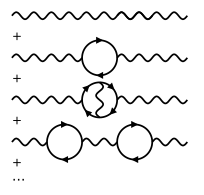In our group of experimental physicist who have nothing to do with and know very little about quantum field theory, we recently had a question concerning the propagation speed of photons in vacuum:
My understanding is that a photon propagating in vacuum has a small probability to spontaneously create a particle/antiparticle pair that will then quickly recombine to emit a photon again. So to fully describe photon propagation, this and other higher-order QFT effects must be considered.

Drawing the analogy to light propagation in a medium, I would expect that these interaction processes might effectively slow down the photon. So we might find that the propagation speed when taking all higher-order contributions into account (lets call it $c_\infty$) is lower than the speed $c_0$ when just considering the interaction-free 0th order.
Because we cannot just switch off all interactions, only $c_\infty$ is experimentally observable. I was wondering how this relates to the speed of light $c$ as it appears in STR.
So my question is, which of the following is true?
$c = c_0 > c_\infty$: Interaction free photons would travel at the speed of light as in STR, but in reality they are slightly slowed down (maybe even depending on the photon energy). The effect is just so tiny that we cannot observe it yet.
$c = c_\infty < c_0$: The speed of light as it appears in STR is the speed of photon propagation after considering all higher-order QFT corrections. Interaction free photons would travel faster, but they cannot exist anyway.
$c = c_0 = c_\infty$: It turns out that considering the higher-order QFT corrections does in fact not change the predicted propagation speed of photons.
The question does not make sense.
